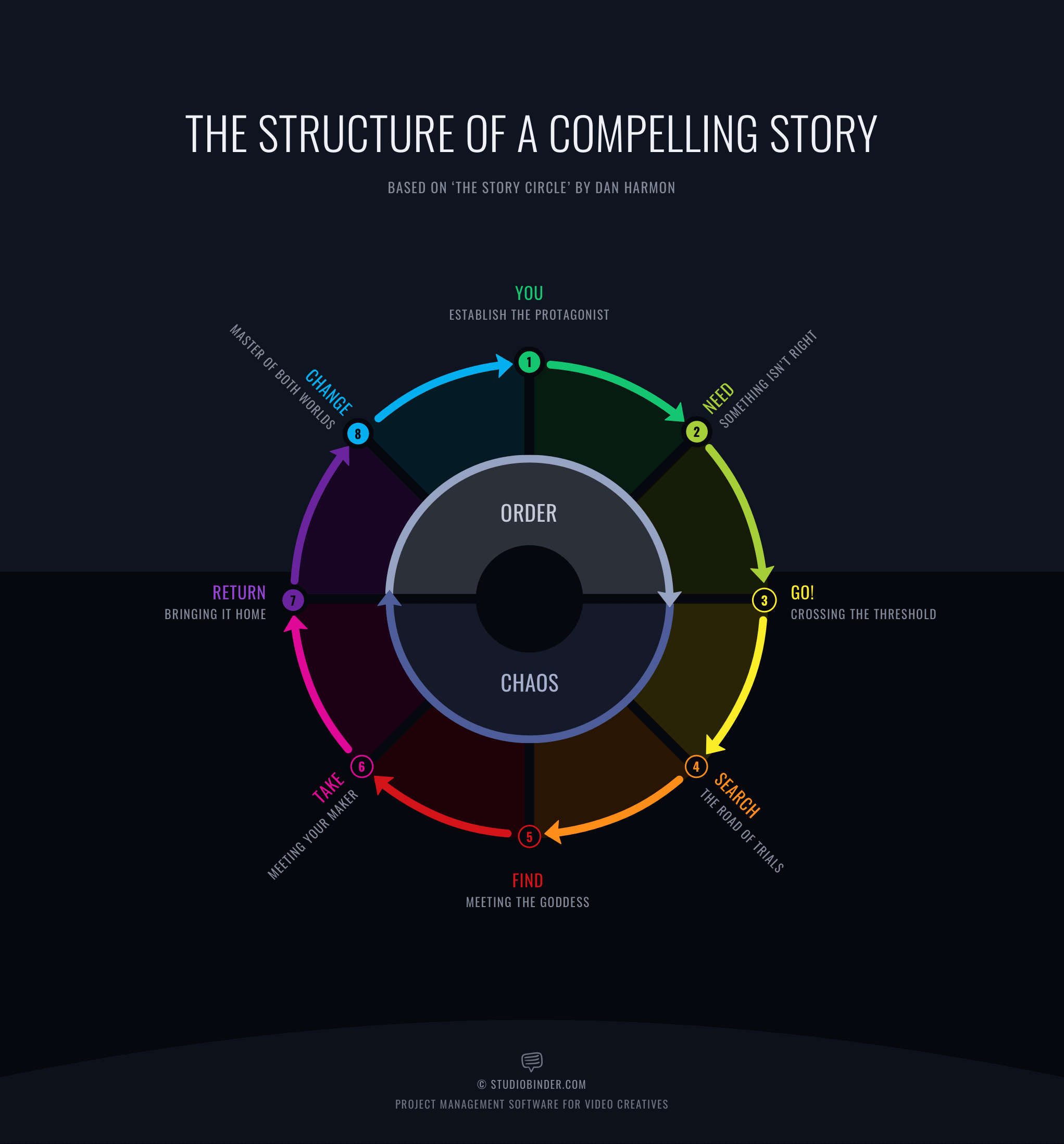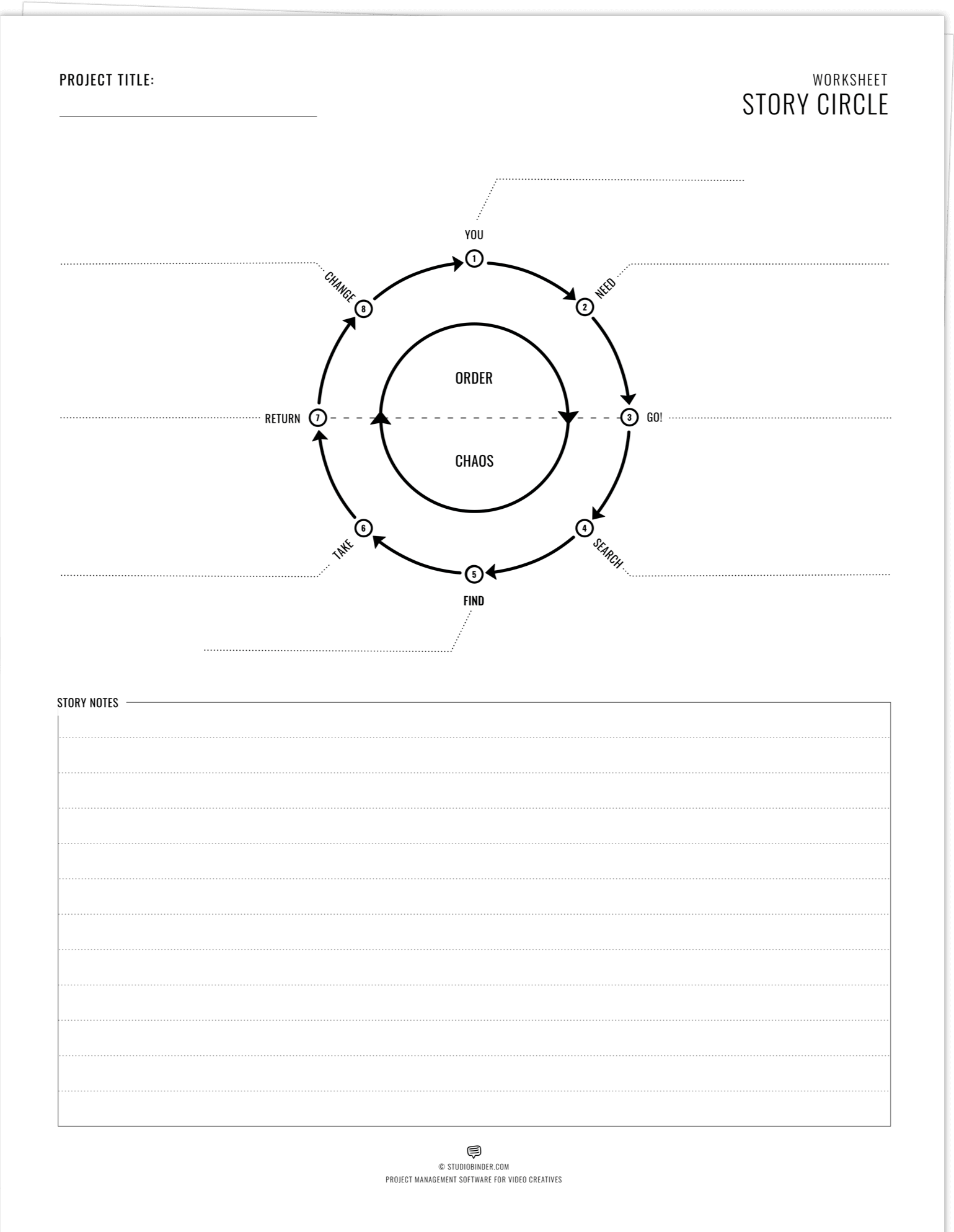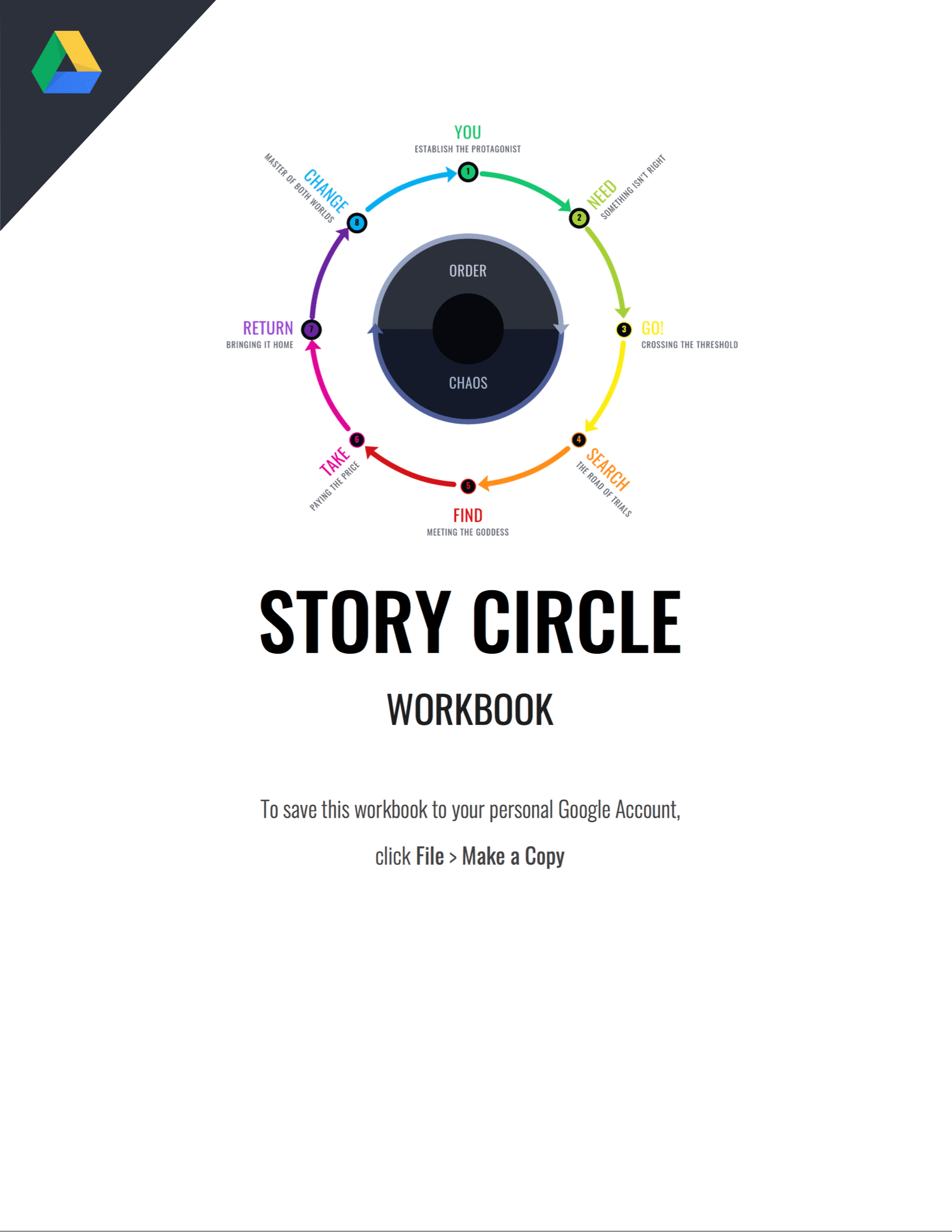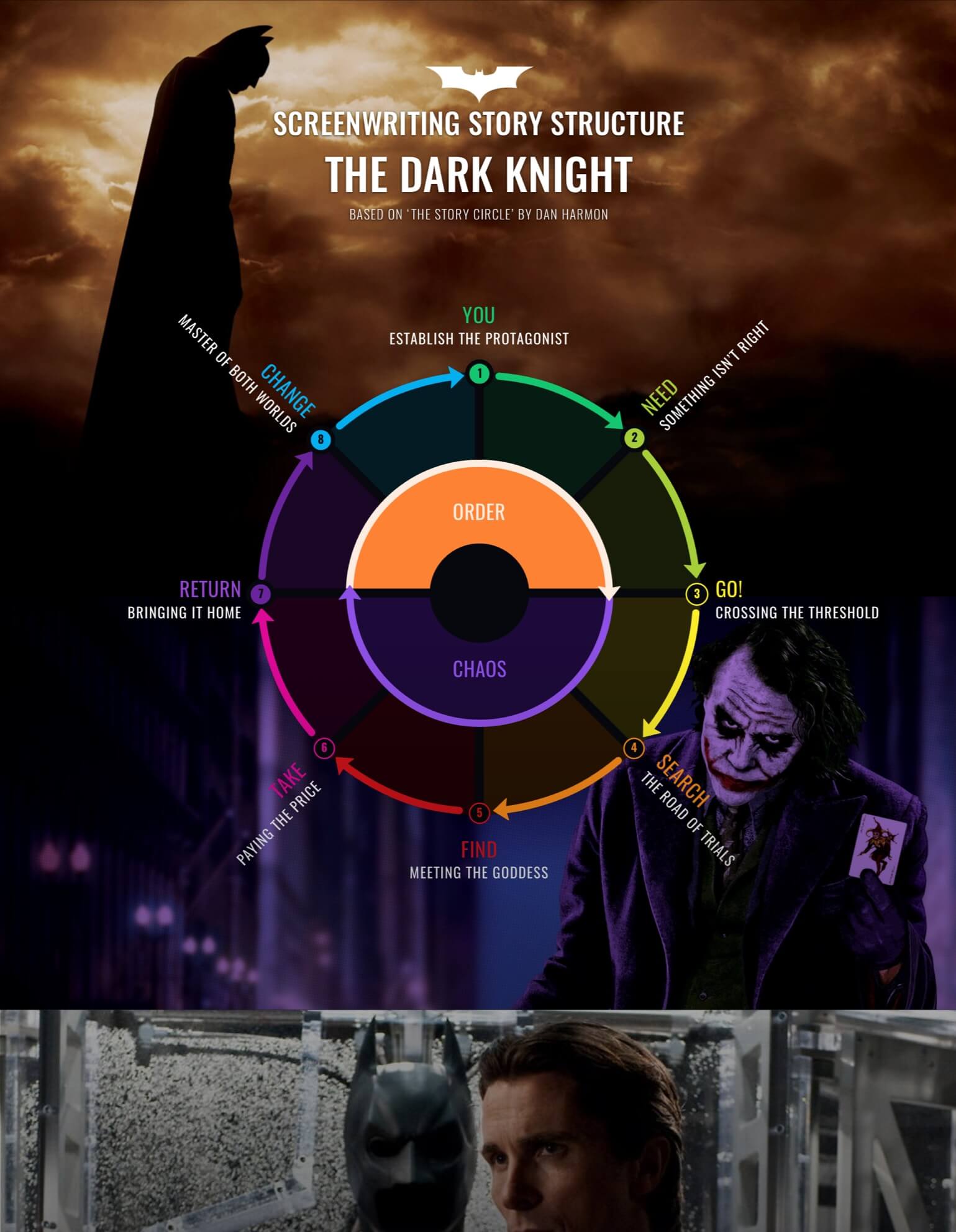T he act of storytelling has always been with us. Anthropologist Joseph Campbell took stories from around the world and found they all shared the same basic structure. Campbell’s Hero’s Journey laid out each of the fundamental steps in this story structure. A few decades later, Dan Harmon took this same idea and created the Story Circle. In Dan Harmon’s Story Circle, there are 8 essential steps that can guide almost any story from Fade In to Fade Out. Let’s walk through each step with examples so you can apply this foolproof structure to your next great idea.
JOSEPH CAMPBELL STORY STRUCTURE
The universal language of storytelling
There are two universal languages. One is math...the other is story. Storytelling is built into the human experience. It's how we pass on our history, where we can learn how to live, and answer questions about "right" and "wrong."
It doesn't take a PhD in English Lit to understand what makes a story good or bad. We all know what a story should do, even if we can't articulate it. Perhaps the most common storytelling element that "makes or breaks" a story is a story structure.
Our goal for today is to lay out one such narrative formula: the Dan Harmon Story Circle. Let's start with a quick definition.
STORY CIRCLE DEFINITION
What is Dan Harmon's Story Circle
The Dan Harmon Story Circle is a story structure divided into eight distinct parts following a protagonist's journey. Also called "The Story Embryo" or "Plot Embryo," these 8 steps follow a character's pursuit of a goal outside of their normal world. Their inevitable return finds them changed, whether or not they achieved their goal.
Writer and director Dan Harmon is most known for his work on Community and Rick and Morty.
8 STEPS IN THE DAN HARMON STORY CIRCLE:
- You — A character is in a zone of comfort,
- Need — But they want something.
- Go — They enter an unfamiliar situation,
- Search — Adapt to it,
- Find — Get what they wanted,
- Take — Pay a heavy price for it,
- Return — Then return to their familiar situation,
- Change — Having changed.
Granted, the eight steps of the Story Circle above are extremely simplified. We will cover each of these in more depth but you should already have a general idea of how the Story Circle works. Here's a diagram that shows both the ordering and the shape of this structure.

The Dan Harmon Story Circle
Why is the Story Circle a circle? Why not a straight line from Step 1 to Step 8? The circle provides an intangible momentum to the story, almost like a rollercoaster.
A protagonist begins at the top must descend figuratively in the story and literally in the circle. At the bottom of the circle, they are at their literal and figurative "low point," and their rise to success in the end is likewise represented visually on the Story Circle.
The first thing you'll notice about Harmon's circle is that it is completely relatable. The stories we tell all the time often (yet naturally) follow Dan Harmon’s Story Circle. Here's the legendary screenwriter himself describing the Story Circle and how it works in an episode of Rick and Morty.
The Dan Harmon Story Circle Explained
You. Need. Go. Search. Find. Take. Return. Change. Those are the eight steps to Dan Harmon’s Story Circle. Because narrative is how we make sense of the world around us. You could also think of the Story Circle as the CliffsNotes to Joseph Campbell's Hero's Journey. Blake Snyder's Save the Cat! is another three-act structure that follows a similar path.
Campbell's work was a big influence for George Lucas while he created the biggest film franchise of all time, Star Wars. You can also see echoes of Campbell's work in The Matrix, Harry Potter, and Lord of the Rings.
Now that we have a general idea of how the Story Circle works, let's dive into each of the eight steps in more detail. Along the way, we'll use Toy Story, Inception, and Star Wars: A New Hope as our case studies.
Grab your FREE Story Circle Bundle!
Put that script through the ringer with our free Story Circle worksheet & template bundle.

Printable Worksheet
Ideal for in-person meetings.



Online Workbook
Ideal for collaborating online.



Story Circle Infographic
Story Circle example: The Dark Knight
Just enter your email address and you'll instantly receive the kit.
DAN HARMON STORY CIRCLE
Step One: You
The essence of the "You" step is to establish the protagonist of the story. It doesn't always need to be a single person. It could be a family or a team. This is our introduction to our main character(s), an opportunity to see them before the story truly begins.
This is important in creating a compelling character arc. A huge part of storytelling is the "change" the protagonist makes during their journey. In this stage, we firmly establish their character arc so we can assess this change at the end. This is also the time to understand the context around the character — their world, its rules, and how they fit inside it.
If we look at our case studies, we can see what the "You" step looks like.
- Toy Story — We meet Woody and see the joy he receives from being Andy's favorite toy.
- Inception — We meet Cobb and are introduced to his work as a contractor stealing information from people's subconscious.
- Star Wars — We meet Luke, stuck working on his uncle's farm, yearning to explore the outside world.
Harmon Story Circle
Step Two: Need
Once we've been introduced to the protagonist and their world, the next step is to figure out what they "need." Something happens to our character that presents a problem or a question (in other words an inciting incident). This is when the story starts to take shape — if "You" is the who of the story, "Need" is the what.
This is where we learn the main goal of the protagonist, the pursuit of which will guide the rest of the story.
- Toy Story — With the arrival of Buzz Lightyear, Woody needs to figure out how to once again become Andy's favorite.
- Inception — Cobb needs to decide whether to take Saito's assignment, which could allow him to return home to his kids.
- Star Wars — As R2-D2 delivers Princess Leia's message, Obi-wan invites Luke to join him in delivering the Death Star plans.
Plot Embryo
Step Three: Go
Needs drive us into action. The "Go" step marks the protagonist's first steps across the threshold in pursuit of the need. This is why you always hear "we need an active protagonist." If there is a "Need" but not a "Go," the story ends. When writing your own script, make your need so vital that it's impossible not to go.
Crossing this 3rd step is also when the protagonist enters the bottom half of the Story Circle. Leaving their normal world behind and officially entering the unknown.
- Toy Story — After Woody knocks Buzz out through the window, the rest of the toys turn on him. Andy takes Woody to Pizza Planet.
- Inception — Cobb sets out to assemble his team for Saito's assignment, including a new architect, forger and chemist.
- Star Wars — When Luke returns home to find his aunt and uncle murdered, he leaves with Obi-wan on their quest to Alderaan.
Story Circle
Step Four: Search
Search is where things begin getting more complicated. Both concerning the story you are telling AND in terms of the process. The character can address the need by searching for an answer. Great stories don't always do this so literally. For Harmon's Story Circle, it works to keep it active and straightforward.
In a big epic feature film drama or a novel, the "search" is going to require more than a physical search. That means it's a series of obstacles the hero must overcome. It's where the rubber meets the road regarding that need.
- Toy Story — Woody finds Buzz but they get trapped at Sid's house where they endure imminent destruction.
- Inception — Cobb's team is ambushed, Saito is shot, they have no choice but to proceed with the plan.
- Star Wars — Alderaan is destroyed by the Death Star while the Millenium Falcon gets caught in its tractor beam.
Harmon Circle
Step Five: Find
Eureka! The hero has searched and searched, and now he's found the Need that sent them on this journey. But is the story over? Nope. Because in a good story, the hero doesn't find what he needs.
He might have found what he wanted, but it turns out he needs something else. Something bigger. This is where plot and character development often collide.
- Toy Story — Woody plans their escape from Sid's house and bonds with Buzz over why it's so great to be a toy.
- Inception — Cobb enlists his target, Fischer, to help break into his own subconscious but Robert is killed and sent to limbo.
- Star Wars — While planning their escape from the Death Star, Luke and Han rescue Princess Leia from the detention block.
Dan Harmon's Story Circle
Step Six: Take
Take whatever you found! And escape with it! Campbell might call this part of the story circle the magic flight. Even though the hero successfully acquires their Need, it comes at a price. Even after their initial success, the protagonist(s) suffer heavily losses.
Depending on the genre, these "losses" could be anything from a temporary setback to the death of a major character.
- Toy Story — As Woody and Buzz attempt to make it back to the moving truck, RC's battery dies, leaving them stranded.
- Inception — Cobb and Ariadne risk entering limbo to rescue Fischer and Saito, Cobb finally lets go of his guilt over Mal's death.
- Star Wars — During their escape from the Death Star, Obi-wan sacrifices himself so that they can get away.
Story Circle Examples
Step Seven: Return
The return stage is coming into the home stretch. The character has brought back into the normal realm whatever they found and took. Be it a magical item, a person, a lesson...and as a result of this they...change.
- Toy Story — Woody and Buzz make return safely to Andy.
- Inception — Cobb emerges from limbo with Saito and awake on the plane, their mission a success.
- Star Wars — The Rebels launch an attack on the Death Star and Luke is able to destroy it.
Harmon Story Circle
Step Eight: Change
The change could be a personal one; it can be change to the world around them. In the instance of a movie or long story, it would be both.
Sometimes the change has opposite effects too. The world has changed for the better, but maybe the protagonist has changed for the worst. Playing with the change step can be interesting.
- Toy Story — Woody learns to co-exist with Buzz.
- Inception — Cobb returns to his children having let go of his guilt.
- Star Wars — Luke has evolved from farm boy to Rebel pilot.
Story Circle
Closing up the Story Circle
Change is what makes it a good story. Change is the key to any story. The 8 steps built into the Dan Harmon Story Circle are designed to facilitate that change.
What do we do when we tell stories? In a basic, primal way, we try to grasp the changes around us. The changes that we can't control. Why do people die? Why does the sun rise each day?
Our stories are how we better understand the world around us. In a way, stories are how we help ourselves cope with change. Reminding ourselves over and again that change will happen, and life goes on.
Grab your FREE Story Circle Bundle!
Put that script through the ringer with our free Story Circle worksheet & template bundle.



Printable Worksheet
Ideal for in-person meetings.



Online Workbook
Ideal for collaborating online.



Story Circle Infographic
Story Circle example: The Dark Knight
Just enter your email address and you'll instantly receive the kit.
up next
How the Save the Cat structure works
If you found the Dan Harmon Story Circle to be a valuable tool, it's time to get writing! If you're looking for a different story formula that breaks the major beats down into more specifics, we've got another option. Blake Snyder's Save the Cat! is another system that takes a simple three-act structure and breaks it into 17 beats instead of 8. Understanding these various story formulas and how they work will get you thinking in concrete terms on how to bring your next script to life.
